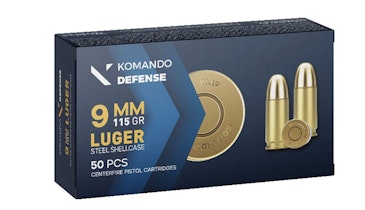Body armor defeats ballistic threats (projectiles and splinter from fragmentation) by slowing them and redirecting their energy. Generally, big, slow threats are easier to stop than small, fast ones. When you're buying body armor, always look for to make sure it is certified body armor. Here in the United States, we use the National Institute of Justice’s (NIJ) standards. The latest Body Armor Performance Standard is 0101.06, referred to as the "oh-six" standard. The main difference between this standard and earlier versions comes down to how extensively the armor is tested. Armor is assigned a “Level” that denotes the ballistic threats it can defeat. There are other standards for the stab and slash threats.
These are the NIJ threat levels at the most generic level:
- Level II: Tested to stop 9mm and .357 Magnum ammunition fired from short-barrel handguns. No rifle ammunition protection.
- Level IIA: Tested to stop 9mm and .40 S&W ammunition fired from short-barrel handguns. No rifle ammunition protection.
- Level III: Tested to stop 7.62mm FMJ lead core rifle ammunition.
- Level IIIA: Tested to stop .357 SIG and .44 Magnum ammunition fired from longer-barrel handguns. No rifle ammunition protection.
- Level IV: Tested to stop .30-cal. steel core armor piercing rifle ammunition.
You'll note that shotgun pellets are not listed among those threats due to their unpredictability.
Since it is nearly impossible to take into account all of the factors that will affect the integrity of armor, industry suggests a five-year service life. However, it also suggests that you inspect your armor regularly and maintain it by storing it flat in a cool, dry space.
When buying body armor, there are three factors to take into consideration. It's up to the customer to decide which factor is most important. Generally, you can have two of these three factors in your favor, but not all three.
- The first and most important is performance. You need to decide which threat you are most likely to encounter and choose a product to defeat it.
- Next comes weight, which is measured in aerial density (pounds per square foot). A corollary to weight, is bulk. For instance, you may have an extremely light hard armor plate, but it is too thick for your use.
- Finally, you must consider cost. Obviously, the lower the cost, the more the other two factors are affected.
Body armor comes in two types. There is soft armor, which is what is found in concealable body armor vests and is used to stop handgun and stab threats. These days, there is a lot of concern over rifle caliber threats. To defeat them, you'll require what is referred to as “hard armor” or “armor plates.”
Soft armor is made from two types of material that can be used alone or in combination. One type of material is aramid, and the other is polyethylene. One popular example of aramid fabric is Kevlar, which is woven. Polyethylene is referred to as “PE” in the business and is a non-woven material. It tends to be lighter, but more expensive than aramid. Often, manufacturers will combine both fabrics to control costs and benefit from properties of each material.
Hard armor is available in stand-alone plate or “in conjunction with” (ICW) configurations. Stand-alone is just that; it will defeat the threat all by itself. In conjunction with plates on the other hand, require soft armor backers to get the job done. Naturally, stand-alone plates are more expensive, making ICW plates more popular.
Plates may be manufactured from ceramics, PE or different types of metal. Generally, they are a combination of these materials. Once again, this controls cost and may enhance the performance. While more exotic metals such as titanium may perform very well for ultra-concealable armor, AR500 steel plate — often used in vehicles — has become very popular due to its low cost. However, you have to be aware of spalling, where hot pieces of the plate fragment can splash into the wearer. Additionally, a lot of the AR500 plates on the market come from dubious sources.
There are numerous carriers on the market for both soft and hard armor. Once again, consider your application when selecting a carrier, whether it's concealability, utility or uniformity. Some carriers feature cutaway systems to allow the wearer to ditch the armor while in water or to gain access to wounds.
You've got take care of your armor so it can take care of you. You should maintain two carriers, particularly for concealable armor, which will be worn directly against the body. They should be rotated and washed regularly. Likewise, soft armor should be inspected and washed with a sponge (not submerged) and a gentle soap. Hard armor plates should also be inspected. Several types can be cracked if dropped, so be careful handling them.
When buying body armor, ensure that you consider your desired protection level first and purchase a system from a reputable source that has been NIJ-certified. This goes for distributors, resellers and consumers.






